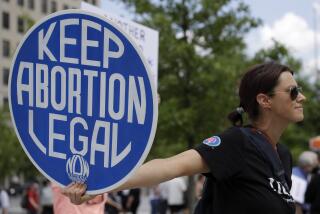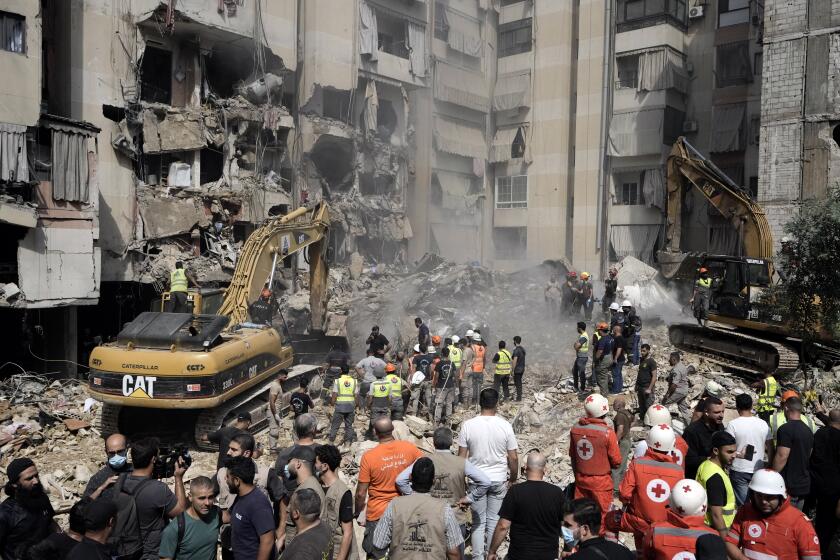Spirit of Ho Pervasive as Vietnam Recalls Victory
Ten years after North Vietnamese tanks rolled into this city and toppled the American-backed government, armor rumbled through the streets again Tuesday in celebration of the Communist victory.
Perched on a reviewing stand only a few hundred yards from the old South Vietnamese presidential palace and not far from what was the American Embassy compound, Vietnam’s top leaders watched stoically under a hot sun as an array of troops and military hardware, some of it captured American-issue, was paraded before them.
On April 30, 1975, Communist tanks had rolled down the same tree-lined road--then called Thong Nhat but since renamed 30th of April Boulevard. The tanks had plowed through the palace gate and ended the long war that claimed the lives of an estimated 1.5 million Vietnamese and more than 58,000 Americans.
“The Vietnam War turned out to be the greatest, hardest and costliest war the U.S. has ever known since World War II, a tunnel with no light at its end,” Nguyen Van Linh, the Communist Party leader in Ho Chi Minh City, said in opening the parade.
“Along with the party, the armed forces and the people of the whole country . . . the party committee, the population and the combatants of our city have executed fully the sacred will of most beloved Uncle Ho.”
The spirit of Ho Chi Minh, the Vietnamese Communist Party founder who died in 1969, hung heavily over the victory celebration. A huge red backdrop behind the main reviewing stand featured a smiling, waving Ho gazing out over the men and women who stuck by him in the wars against the French and Americans and who now rule the reunited country.
His pictures were sprinkled throughout the parade route and adorned almost every float. One placard, preceding a marching group of young athletes, depicted Ho hoisting a pair of dumbbells.
Beneath the picture was a banner with a saying of Ho that Vietnamese find inspirational: “Let Everyone Do Exercise in the Morning.”
Authorities said more than 50,000 people, including 10,000 military personnel, took part in the ceremonies. On the main reviewing stand sat most of the top officials from Hanoi: Communist Party leader Le Duan, Premier Pham Van Dong, President Truong Chinh, Gen. Van Tien Dung, who directed the final North Vietnamese offensive in 1975, and others.
American war protester David Dellinger, who accepted the government’s invitation to witness the festivities, sat with other honored guests in a nearby set of bleachers. Dozens of the nation’s top military officers, red ribbons and gold stars dangling from the chests of their baggy uniforms, stood at attention by the stands.
Gen. Giap Is Absent
Absent without explanation, however, was Gen. Vo Nguyen Giap, former defense minister and military leader of the northern forces during the war.
Le Duc Tho, the veteran party official who negotiated the Paris peace accords with Henry A. Kissinger in 1973, was in the city but was being interviewed for an American television show and did not appear on the stand.
Military units led the parade, with regulars from the armed forces goose-stepping past the reviewing stand. Some wore the familiar green uniforms and pith helmets of the North Vietnamese divisions and carried the AK-47 assault rifles that are a trademark of Communist armies.
The regulars were followed by militias made up of factory workers carrying American M-16 rifles captured in the collapse of the South Vietnamese army.
Women from a signal unit, wearing blue tennis shoes and curlers in their hair, marched by with field radios strapped to their backs and wobbly antennas dangling over their heads. A naval unit wore French-style white caps, without the pompons, and blue-striped shirts under their white blouses.
A Soviet Accent
The accent in arms was definitely Soviet. Groups of MIG-21s and Soviet-made helicopter gunships, with rockets mounted, made passes over the parade route. Soviet 180- and 130-millimeter guns and T-54 battle tanks lumbered past the reviewing stand, along with a range of anti-aircraft guns, rocket launchers and anti-aircraft missiles.
A group of National Liberation Front (Viet Cong) veterans were ferried on the backs of motorbikes.
The non-military participants were led down the route by large posters of the Communist pantheon: Marx, Engels and Lenin in the first rank and Ho Chi Minh alone in the second, with other Vietnamese party heroes behind.
The parade ended on the peace-and-brotherhood theme of the Communist world: aerobic gymnasts trailing ribbons, marching units waving flowers, plywood floats from factories (some bearing graphs showing their recent production figures), red Russian tractors, gleeful, brightly clad youngsters dancing--even roller skaters.
And, as if to counter Western allegations that the regime has repressed Buddhists and Roman Catholics, delegations of monks, priests and nuns were in the parade, led by a float featuring saffron-robed bonzes crowded around a bust of Ho and a huge gold Vietnamese star.
Spectators jammed the mall between the presidential palace--now called Reunification Palace--and the stately Central Catholic Cathedral, pressing against each other and spilling over police lines. Police beat several spectators with bamboo canes to force them back off the road.
Youngster Arrested
As the parade broke up, police arrested an Amerasian youngster in the crowd when he approached a Times reporter. The black-skinned youth, who spoke no English, appeared to be trying to write his father’s military service number in the reporter’s notebook when an officer pushed him away with a cane and then clapped handcuffs on him.
In general, however, the mood Tuesday was festive. The day was declared a holiday, a rare occurrence here. Vendors were doing a brisk business in crushed-ice drinks, and bicyclists filled the streets.
So did police in their pea-green uniforms. With so many Hanoi officials in the city, security was tight.
At night, several fireworks displays lit the sky.
Throughout the last week, the government tried to put its best foot forward, even while anticipating some barbs from the almost 200 Western and Japanese reporters and technicians invited to record the ceremonies.
The city had been given a cosmetic treatment of new paint and flowers, and the national flag, a gold star on a red field, was flying from nearly every structure.
Slogan-Bearing Banners
Patriotic banners of the same colors were hung from taller buildings. Red banners, festooned along the parade route and hung across several main thoroughfares, carried slogans such as “Long Live the Vietnamese Communist Party” and “President Ho Chi Minh Will Live Forever in Our Cause.”
The spectators at the main reviewing area of the parade were handpicked by district organizations, residents said. Reporters who had been here in previous months said the authorities had obviously swept the downtown area clean of people who once slept in the streets.
Every effort was made to accentuate the positive. Still, a Hanoi press official bantering with American reporters, said : “I don’t know why we let you in. All you do is criticize us.”
Press events were set up to try to answer many of the hard questions that the government knew were coming. Still, some answers were evasive, meaningless or simply not given.
Questions about Ho Chi Minh City were fielded at a press conference by Vai Chi Tho, chairman of the city’s People’s Committee and brother of Politburo member Le Duc Thom. He said the economic, political and social transformation of the “former consuming society full of social evils . . . into a producing city of working people living together in love and justice” was on schedule, with some exceptions.
Reclusive Holy Men
When asked whether there had been government repression of the Buddhist community, since monks were rarely seen on the streets, Tho responded blithely that the holy men simply stayed in their pagodas more nowadays.
When a questioner pointed out that there appeared to have been far more monks when this city was the capital of South Vietnam, Tho suggested that some of them were merely draft dodgers seeking religious exemptions.
The politically touchy question of re-education camps--a Hanoi euphemism for concentration camps for political prisoners, including former South Vietnamese soldiers and officials--was handled with a trip to a model camp near the city of Xuan Loc.
The prisoners’ compound and barracks at Camp K-4 are on one side of the road. On the other is a splendid park of carp ponds, ornate guest houses and landscaped gardens built and maintained by the prisoners.
The press was taken to the latter, where a ticket booth at the front gate carries a sign that, translated from the Vietnamese, said: “Admission Five Dong. Children Under 10 Free.”
Volleyball With Music
Once inside, the journalists were ushered to a graceful wooden guest house. The view from the balcony was a group of prisoners playing volleyball to the accompaniment of a band that played a jaunty tune.
Le Nhan, a big southerner with a short, military haircut--under prodding he finally admitted being an army major--is chief of the security force at the camp, and he fielded the initial questions.
He would not give a precise number for the inmates but said it is fewer than 1,000.
He said they had built the park in their work hours, for which they are paid anywhere from 300 to 2,000 dong a month, the former a good salary by Vietnamese standards and the latter four times greater than doctors and the highest-ranking government officials.
Two Nervous Ex-Officers
Two former South Vietnamese army officers were produced for questioning, both obviously nervous in the huddle of camp security personnel, government officials and the foreign press.
One, 42-year-old former Capt. Nguyen Hoang Anh, said he was first interned in 1975, released in 1982 and rearrested in 1984. Why?
“For joining the counterrevolutionary forces,” he said.
He was imprisoned without trial, and he said he earns no salary for his work because he has not been in the camp long enough.
Many of the questions put to the prisoners and camp officials were not answered.
“Camp regulations,” the security chief said.
More to Read
Sign up for Essential California
The most important California stories and recommendations in your inbox every morning.
You may occasionally receive promotional content from the Los Angeles Times.










